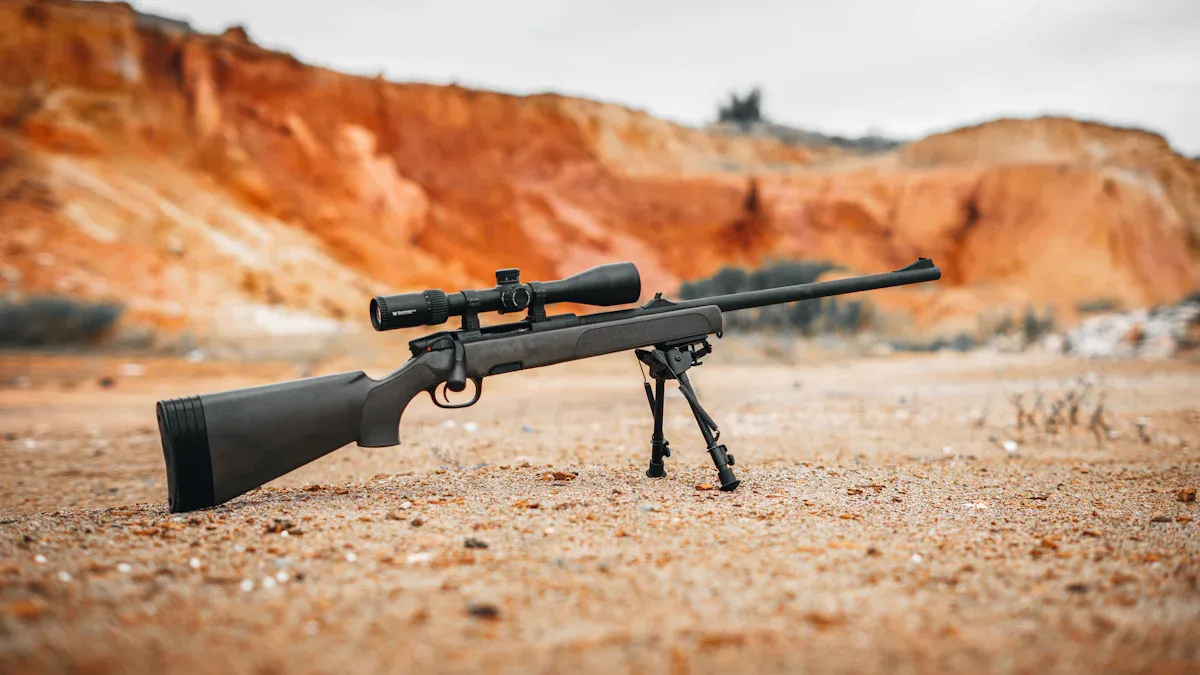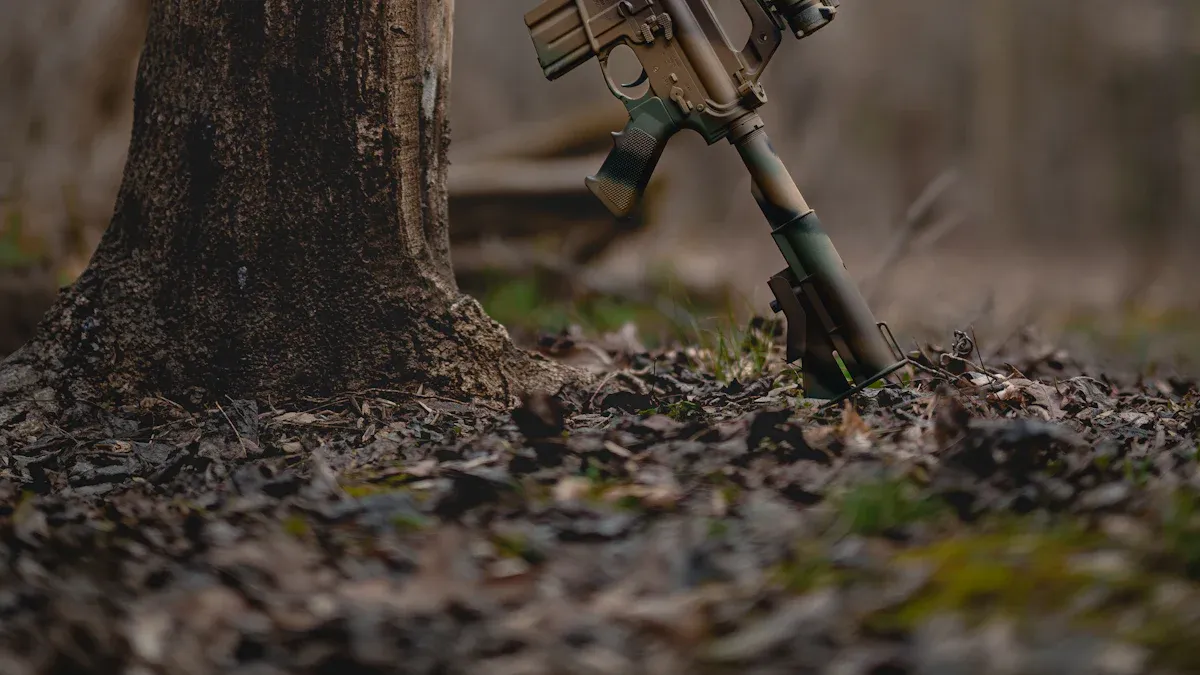
A rifle bipod can make or break your shooting experience in extreme conditions. Imagine setting up your rifle scope on uneven terrain, only to have it wobble at the worst moment. That’s where a weatherproof bipod shines. Built to endure rain, mud, and heat, it mounts securely to your rail and keeps your aim steady. These accessories are the unsung heroes of precision shooting.
Key Takeaways
- Weatherproof rifle bipods help you shoot better in tough weather.
- Strong materials like aluminum and carbon fiber make them last longer.
- Cleaning and storing them right keeps them working well for years.
Why Weatherproofing Matters
Impact on Performance
A weatherproof rifle bipod can transform a frustrating shooting experience into a seamless one. Imagine setting up for a shot, only to have your bipod slip on wet ground or freeze in icy conditions. Weatherproofing ensures the bipod performs consistently, no matter the environment. It keeps the rifle stable, even when the ground is muddy or uneven. This stability can mean the difference between hitting the target or missing entirely. Shooters who rely on their gear in extreme conditions know that a dependable bipod is not just a luxury—it’s a necessity.
Enhancing Durability
Durability is the backbone of any reliable rifle bipod. Weatherproof materials like 6061-T6 aluminum or carbon fiber resist corrosion and wear. These materials can endure harsh conditions without cracking, warping, or rusting. A well-built bipod can last for years, even with regular exposure to rain, snow, or heat. Investing in a weatherproof model saves money in the long run by reducing the need for frequent replacements. Plus, it provides peace of mind knowing the equipment won’t fail when it’s needed most.
Real-World Examples of Weather Challenges
Extreme weather can test even the toughest gear. Heavy rain can turn dirt into slippery mud, making it hard to stabilize a rifle. Snow and ice can freeze moving parts, rendering a bipod useless. Scorching heat can weaken inferior materials, causing them to warp or crack. A weatherproof rifle bipod stands up to these challenges. It keeps functioning, whether in a downpour, a snowstorm, or under the blazing sun. Shooters who venture into unpredictable environments need gear that can handle anything nature throws their way.
Key Features to Look For

Material Durability
A rifle bipod must be tough enough to handle the harshest conditions. Materials like 6061-T6 aluminum and carbon fiber are popular choices. Aluminum offers a balance of strength and weight, while carbon fiber provides exceptional durability without adding bulk. Both materials resist corrosion, making them ideal for wet or humid environments. For shooters who demand longevity, these materials ensure the bipod won’t crack, warp, or rust after repeated use.
Pro Tip: Look for bipods with weather-resistant coatings. These coatings add an extra layer of protection, especially in extreme weather.
Adjustability and Stability
Adjustability and stability are game-changers for any rifle bipod. Telescoping legs allow shooters to adapt to uneven terrain, while ball and socket technology provides smooth movement. For example:
- The MDT Ckye-Pod offers a height adjustment range from 9.5 to 18 inches, making it versatile for different shooting positions.
- The XDS-2 Tactical Bipod can pan 20 degrees and cant 25 degrees, ensuring stability even on sloped surfaces.
- The Accu-Tac B4 bipod excels on uneven ground, with panning capabilities that help track moving targets.
These features ensure the rifle stays steady, whether on rocky hills or muddy fields.
Resistance to Environmental Factors
A weatherproof rifle bipod must withstand water, mud, and extreme temperatures. Non-slip rubber feet or spiked feet provide a firm grip on slippery or loose surfaces. Durable coatings protect against rust and wear, even in heavy rain or snow. Lightweight designs, like those made from carbon fiber, resist heat damage during scorching summers. Shooters venturing into unpredictable environments need a bipod that performs flawlessly, no matter the conditions.
Did You Know? Some bipods feature quick-deploy legs, allowing users to set up in seconds when time is critical.
Top Weatherproof Rifle Bipods for Extreme Conditions

Rugged Ridge Outdoor Gear Gen 3 Extreme Bipod: Pros and Cons
The Rugged Ridge Outdoor Gear Gen 3 Extreme Bipod is a lightweight yet durable option for extreme conditions. Weighing only 13.5 ounces, it’s easy to carry during long treks. Its innovative adjustability, including a new mounting option and extra width notch, allows for precise height adjustments. Made from 6061-T6 aluminum and heat-treated stainless steel, this bipod resists corrosion and wear. Textured twist locks provide a secure grip, even in wet or muddy conditions.
Pros:
- Lightweight construction for portability.
- Durable materials ensure longevity.
- Quick detach Picatinny mounting system for convenience.
Cons:
- Limited to Picatinny rails, reducing compatibility with other mounting systems.
Extreme Pod GEN 2: Pros and Cons
The Extreme Pod GEN 2 stands out for its adjustability and innovative design. Users praise its ball and socket technology, which enhances maneuverability. The legs extend smoothly and lock with a satisfying click, making it user-friendly. Many hunters and shooters have shared success stories, highlighting its reliability in real-world scenarios.
-
Pros:
- Exceptional adjustability with ball and socket technology.
- Smooth leg extension and secure locking mechanism.
- High-quality build comparable to premium models.
-
Cons:
- Feet lack tackiness, which may reduce grip on slippery surfaces.
SEA12 Bipod: Pros and Cons
The SEA12 Bipod offers excellent flexibility and adaptability for backcountry hunting. Its rubber-covered leg joints provide extreme flexibility, while the height range of 9-12 inches is ideal for prone shooting. However, it lacks a quick detach lever and spring tension adjustment, which may limit its usability in fast-paced situations.
| Feature/Aspect | Pros | Cons |
|---|---|---|
| Flexibility | Rubber-covered leg joints for flexibility | Limited control over leg flexibility |
| Height Range | Ideal for prone shots (9-12 inches) | No quick detach lever |
| Adaptability | Adjustable angles for uneven terrain | Slight play in legs affects stability |
This rifle bipod is a solid choice for hunters who prioritize flexibility and adaptability in rugged environments.
How to Choose the Right Bipod
Assessing Individual Needs
Choosing the right bipod starts with understanding the shooter’s needs. Hunters often prioritize lightweight and portable designs. A hunter stalking prey in dense woods might prefer a compact bipod that folds easily. Competitive shooters, on the other hand, lean toward stability and precision. For example, the MDT Ckye-Pod dominates competitive shooting, with 57% of pro shooters favoring it for its versatility and adjustability.
The type of hunting also plays a role. Tree stand hunters may need a bipod with longer legs for better clearance, while ground hunters benefit from shorter, more stable options. Reviews from experienced shooters can provide valuable insights. They often highlight features like user-friendliness and durability, helping others make informed decisions.
Considering Rifle Type
Not all bipods fit every rifle. Compatibility with the rifle’s stock and attachment system is crucial. A poorly matched bipod can cause instability, affecting accuracy. Shooters should check whether their rifle supports Picatinny, M-LOK, or swivel stud mounts. Aluminum bipods are often preferred for their durability and stability, especially when paired with heavier rifles. Balancing weight and quality ensures the bipod complements the rifle without compromising performance.
Evaluating Environmental Conditions
The terrain and weather conditions also influence the choice of a bipod. Muddy fields demand spiked feet for grip, while rocky terrain benefits from rubberized feet. Extreme temperatures can test the durability of materials. Aluminum and carbon fiber excel in such conditions, resisting both heat and cold. Shooters venturing into unpredictable environments should prioritize weatherproof designs. Features like quick-deploy legs and adjustable angles enhance usability in challenging terrains.
Pro Tip: Always consider the weight of the bipod. A lighter option may be easier to carry, but heavier models often provide better stability.
Maintenance Tips for Longevity
Cleaning and Care
A weatherproof rifle bipod might be tough, but it still needs regular cleaning to stay in top shape. Mud, dirt, and debris can sneak into the joints and moving parts, causing wear over time. Shooters should start by wiping down the bipod with a damp cloth to remove surface grime. For stubborn dirt, a soft-bristle brush works wonders.
Pro Tip: Use compressed air to blow out debris from hard-to-reach areas. It’s quick, easy, and keeps the bipod functioning smoothly.
After cleaning, a light coat of lubricant on the moving parts prevents rust and ensures smooth operation. Avoid over-lubricating, as excess oil can attract more dirt. A clean bipod not only looks good but also performs better in the field.
Storage Recommendations
Proper storage can extend the life of any rifle bipod. A dry, cool place is ideal to prevent rust and material degradation. Avoid leaving the bipod in direct sunlight or damp areas, as extreme conditions can weaken even the toughest materials.
Did You Know? Storing the bipod in a padded case protects it from accidental bumps and scratches.
For long-term storage, consider loosening any tension adjustments to reduce stress on the components. This simple step ensures the bipod stays ready for action when needed.
Real-Life Maintenance Scenarios
Imagine returning from a rainy hunting trip. The bipod is caked in mud, and water drips from its legs. First, rinse off the mud with warm water. Then, dry it thoroughly with a microfiber cloth. A quick spray of rust-preventive oil keeps corrosion at bay.
Quick Tip: Always inspect the bipod after cleaning. Look for loose screws or worn parts and tighten or replace them as needed.
Regular maintenance like this ensures the bipod remains reliable, even after the toughest adventures.
A high-quality weatherproof rifle bipod is more than just an accessory—it’s a game-changer. Durable materials, adjustable legs, and non-slip feet ensure stability in any environment. Shooters who invest in premium models enjoy better performance and fewer replacements. Reviews from seasoned users highlight the value of reliable gear. Why settle for less when precision matters most?
Post time: Mar-27-2025
